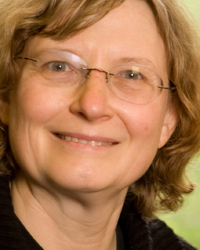
|
|
CULTURAL HERITAGE : DISTINGUISHING THE "HAND" OF THE MASTER? 
Ingrid Daubechies Professor of mathematics at Duke University. Location: Gold Hall Date & Time: Wednesday, September 14, 13:00-14:00 Abstract:
Paintings by Goossen van der Weyden, an early 16th century Flemish painter, have long been known not all to be entirely of the hand of the master himself -- it was customary in his time that artists employed one or more apprentices in their workshops, who could be given the task to execute (less crucial) parts of some paintings. As is customary in 16th century paintings as well, many show underdrawings, which can be made visible by infrared reflectometry. In the case of Goosen van der Weyden, some of these underdrawings are much more structured than others, giving more technical guidance for the subsequent operation of painting; different underdrawing styles can occur within the same painting. An interesting question, from the art historical point of view, is whether the painting style, as characterized by an analysis of the visible detail of the painted surface, can be classified "blindly" (i.e. without a priory knowledge of the underdrawing style) in accordance with the underdrawing classification. We studied this question, and found that this was indeed the case. Work done in collaboration with Robert Calderbank, Sina Jafarpour, Maximiliaan Martens and Josephine Wolff. Biography: Daubechies was born in Houthalen, Belgium, as the daughter of Marcel Daubechies (a civil mining engineer) and Simonne Duran (then a homemaker, later a criminologist). Daubechies completed her undergraduate studies in physics at the Vrije Universiteit Brussel in 1975. She obtained her Ph.D. in theoretical physics in 1980, and continued her research career at that institution until 1987, rising through the ranks to positions roughly equivalent with research assistant-professor in 1981 and research associate-professor 1985. In 1985 Daubechies met mathematician Robert Calderbank, then on a 3-month exchange visit from AT&T Bell Laboratories, New Jersey to the Brussels-based mathematics division of Philips Research; they married in 1987. Daubechies then moved to the United States, taking a position at the Murray Hill AT&T Bell Laboratories' New Jersey facility. Earlier that same year, she had made her best-known discovery: the construction of compactly supported continuous wavelets. Since 1993, Daubechies has been a full professor at Princeton University, where she is active especially within the Program in Applied and Computational Mathematics. She was the first female full professor of Mathematics at Princeton. In January 2011 she moved to Duke University to serve as a professor of Mathematics. She is the president of the International Mathematical Union (2011–2014). The name Daubechies is widely associated with • the orthogonal Daubechies wavelet • and the biorthogonal CDF wavelet. A wavelet from this family of wavelets is now used in the JPEG 2000 standard. Awards:
She received the Louis Empain Prize for Physics in 1984, awarded once every five years to a Belgian scientist on the basis of work done before the age of 29. Between 1992 and 1997 she was a fellow of the MacArthur Foundation and in 1993 was elected to the American Academy of Arts and Sciences. In 1994 she received the American Mathematical Society Steele Prize for Exposition for her book Ten Lectures on Wavelets and was invited to give a plenary lecture at the International Congress of Mathematicians in Zurich. In 1997 she was awarded the AMS Ruth Lyttle Satter prize. She was elected to the United States National Academy of Sciences in 1998. In 2000 Daubechies became the first woman to receive the National Academy of Sciences Award in Mathematics, presented every 4 years for excellence in published mathematical research. The award honored her "for fundamental discoveries on wavelets and wavelet expansions and for her role in making wavelets methods a practical basic tool of applied mathematics." In January 2005, Daubechies became just the third woman since 1924 to give the Josiah Willard Gibbs Lecture sponsored by the American Mathematical Society. Her talk was on "The Interplay Between Analysis and Algorithm." Ingrid Daubechies was the 2006 Emmy Noether Lecturer at the San Antonio Joint Mathematics Meeting. Read her profile from the AWM. In September 2006, the Pioneer Prize from the International Council for Industrial and Applied Mathematics was awarded jointly to Ingrid Daubechies and Heinz Engl. The citation for Daubechies reads as follows: The ICIAM/SIAM Pioneer Prize is awarded to Ingrid Daubechies, Princeton University, Princeton, USA, for her pioneering work in applied mathematics and applications. Her work is a permanent contribution to mathematics, science and engineering and has found widespread use in image processing and time frequency analysis. Daubechies best known achievement is her construction of compactly supported wavelets in the late 1980s. Since that time she has advanced the development of biorthogonal wavelet bases. These bases are currently the most commonly used bases for data compression. Daubechies name is widely associated with the biorthogonal CDF wavelet. Wavelets from this family are currently used in JPEG 2000 for both lossless and lossy compression. Her continuing wavelet research also resulted in path-breaking work including the discovery of Wilson bases. This discovery led to the existence of cosine packet libraries of orthonormal bases and Gaussian bases. These are now standard tools in time frequency analysis and numerical solutions of partial differential equations. |
©2011 UCL/TELE || icip2011-webmaster@listes.uclouvain.be || Last updated September 06, 2010, at 03:01 PM